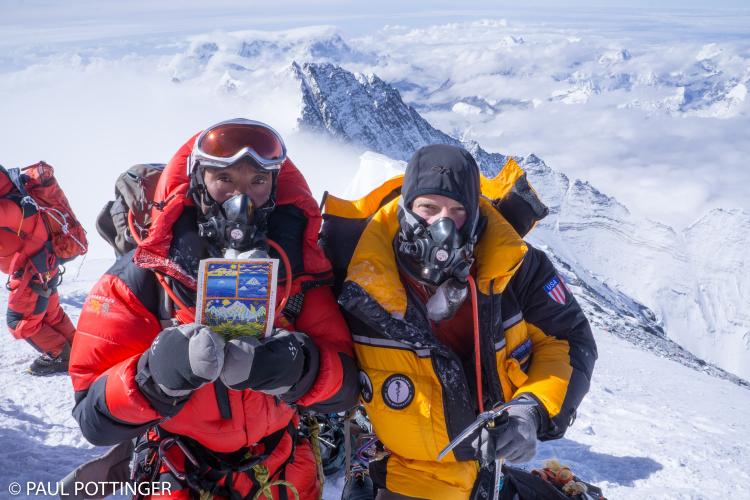
Faculty Spotlight: Paul Pottinger
From germs to summit
Paul Pottinger dreamed of climbing Mt. Everest since he was in second grade. After starting to train seriously in 2007, his first attempt in 2015 ended when a devastating earthquake halted the climbing season. He remained determined to try again in 2016.
Everest: The basics
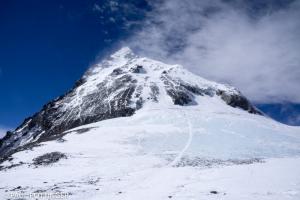
Mt. Everest, at 29,029 feet above sea level, is the world’s highest mountain. It is located in the Mahalangur mountain range (part of the Himalayas) in Nepal; the international border between Tibet and Nepal runs across its summit.
Hundreds of people attempt to climb it each year, usually from the North (Tibetan) or South (Nepalese) sides.
Expense
Most climbers use a professional guide service. The expertise, safety record, and amenities provided by guiding outfits vary widely, and they may charge anywhere between $35,000 to more than $100,000. Airfare, climbing permits, visas, climbing gear, and insurance add to this cost. Plus, wages lost during an unpaid leave must be taken into account.
Time
Everest can be climbed in spring or fall; winter is too cold, and summer brings heavy “monsoon” snowfall. An expedition typically takes 8-9 weeks. Much of that time is spent acclimating to the elevation, which involves climbing and descending various parts of the mountain and surrounding peaks.
Risks
In the death zone (altitudes higher than 26,000 feet) climbers can survive only two or three days, even with the use of supplemental oxygen.
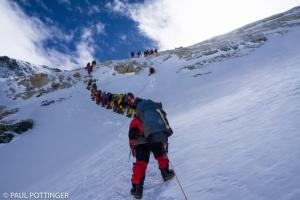
Approximately 280 people have died trying to climb the mountain and, over the past several decades, deaths have occurred every year. Causes include avalanches, falls, hypothermia, high-altitude pulmonary edema (HAPE) and high-altitude cerebral edema (HACE).
Problems on the mountain may be caused by inexperienced climbers and too many climbers, which result in traffic jams on the route. These delays can be catastrophic.
Pottinger’s motto: Coming back down is always more important than going up. Also, he subscribes to the ABC’s of climbing: Always Be Clipping (the safety line).
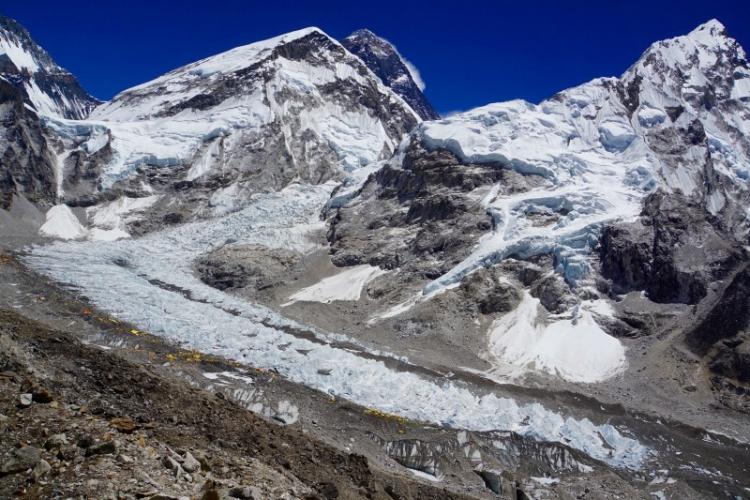
First attempt: 2015
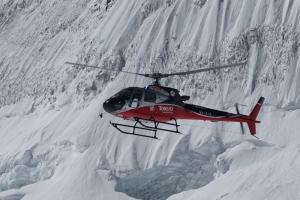
Pottinger’s first attempt was going well. He and his team had reached Camp 2 when a 7.8 magnitude earthquake struck Nepal on April 25.
Pottinger’s expedition was safe at 21,300 feet, but they soon learned that the central section of Everest Base Camp (EBC) was destroyed by the sonic blast of a massive avalanche from Pumori.
Many were saved by teams at base camp, but tragically, 19 lost their lives. For climbers above, the avalanche made it impossible to safely descend the already treacherous Khumbu Icefall (between Camp 1 and EBC).
They were trapped.
In the biggest helivac operation in Himalayan mountaineering history, over 150 climbers were airlifted from Camp 1 down to EBC.
The earthquake in Nepal killed more than 9,000 people and left tens of thousands homeless, in a nation already notorious for its poor infrastructure.
The expedition was over.
Second attempt: 2016
He returned the following March, with many of the same teammates from 2015. By the time the group reached EBC in early April, Pottinger had already developed a cough.
The “Khumbu cough” is common on Everest, and likely is a product of airway irritation due to dusty, cold dry air…and in some cases, lung infection. During the coming days, when the team acclimatized at Camps 1 and 2, his cough worsened and he started to have pain in his right chest.
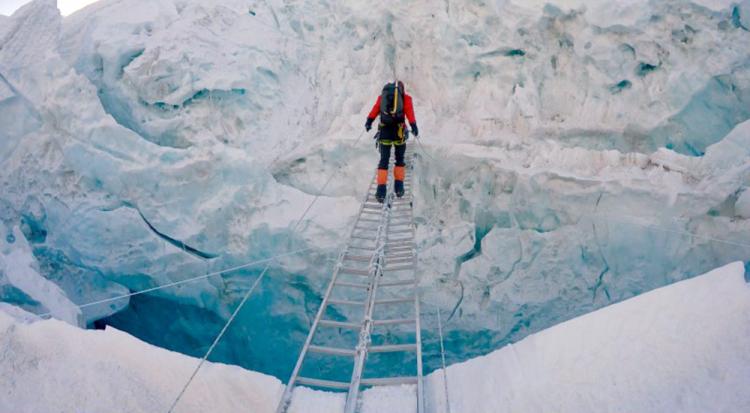
After a few days of rest, the group was ready to head back up. The plan was to spend a night each at Camps 1, 2, and 3, without supplemental oxygen, before heading back down to recover prior to attempting the summit. Breathing ambient air while sleeping at Camp 3 (23,700 feet) should trigger a beneficial acclimatization reaction. It is often regarded by climbers as the most miserable night of their life.
Climbing the first ice bulge out of Camp 3. Plume blossoming from the summit of Everest on the left.
Because he had only made it to Camp 2 in 2015, reaching Camp 3 for the first time finally felt like progress.
"Oh my god we are climbing Everest now,” he thought.
But his cough worsened. Since Pottinger specializes in infectious diseases, he created a game where he would name the sputum that he coughed up. Examples included a Kumamoto Oyster, a Penn Cove Mussel and a red sea cucumber (for a specimen streaked with blood).
His cough persisted after returning to EBC. Pottinger, and a few others who were also suffering with respiratory issues, decided to fly down to Namache Bazaar (11,200 feet) to rest and recover in the thicker, moister atmosphere there. Within days their symptoms improved and they felt ready to make a bid for the summit.
Tragedies on the mountain
The team started their summit push on May 15. They reached Camp 3 four days later, when a tragedy struck. A Sherpa climber from another group fell from high on the Lhotse Face and slid past Pottinger’s group.
He did not survive.
Shaken deeply, they headed out of Camp 3 the following day as planned. Pottinger was having a difficult time getting into a rhythm, but wanted to appreciate the enormity of what he was doing.
“I had envisioned this part of the climb every day for the last year. I had dreamed of this section. And now, I was climbing into that dreamscape. I wanted to step to the beat of a metronome pulsating from deep beneath the mountain…to kick my feet into the ice and send reverberations out into the master plan of the universe…to savor each moment as a fulfillment of my lifetime’s ambition.”
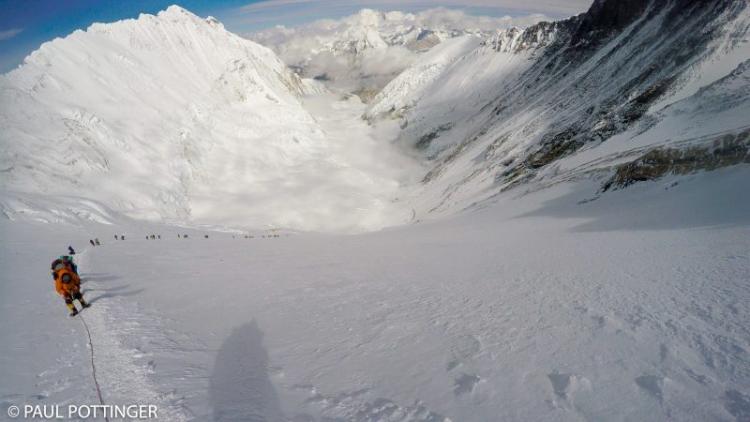
Suddenly a body slid down the mountain, hurtling by them. Pottinger saw the IMG logo on his oxygen mask. IMG stands for International Mountain Guides, the group Pottinger was climbing with. His heart sank as he realized the fallen climber was his friend.
“That’s my team mate. My tent mate. My friend.”
The climber’s fall stopped unexpectedly on a crevasse’s snowbridge, where he jolted to a halt. IMG’s mountaineering doctor (Emily Johnston, UW School of Medicine, 2006) went to help him while the rest of the group watched in shock and amazement. Less than 24 hours earlier, the Sherpa climber had taken the same fall but with fatal results.
Fortunately, he was not seriously injured, and was able to continue up soon thereafter.
Thrilled for his friend, Pottinger refocused on the climb ahead. He did not realize until after he was home that he had climbed the world's tallest mountain with a broken rib. He must have subconsciously suppressed this possibility because, he said,
"Climbing Everest with a rib fracture would be crazy. Besides, so long as I kept my chest and arm at the proper angle, and so long as I did not cough, it really did not hurt.”
The summit
He tried to get a few hours of sleep before departing. But all he could think about was the summit.
“After all this time, it’s right there, just outside the door. Waiting for me.”
He left at 9:30 PM, breathing 4 liters per minute of supplemental oxygen. Climbers from other teams with a variety of skill levels and experience shared the route, adding to the challenge. “We climbed under a full moon, with mild winds and clear skies. Conditions don’t get much better than that. The mountain was kind to us… although others were not so fortunate.”
On May 21, 2016 at 7:30 AM, Paul Pottinger successfully summited Mt. Everest.

He is proud to have made it, and to have worn the W on top. But he is also very humble. “This was a team effort for sure. I was lucky to climb with such talented guides and teammates. I could never have done it without them…or without so much support from my family and colleagues at UW.”
Tragically, five climbers from other expeditions died during this summit push.
“Knowing that some did not come home alive…no matter who they were or the reason why, six months later, it’s still heartbreaking," he says. "It’s still very hard to take. I am so proud of our guides. They worked incredibly hard on behalf of fallen strangers, and they had some great saves. That’s something positive to focus on.”
The future
His personal goal is to climb the Seven Summits by his 50th birthday. The Seven Summits are the highest peaks on each of the seven continents and include: Everest, Kilimanjaro, Vinson Massif, Denali, Aconcagua, Kosciuszko, and Elbrus.
At age 48, he has climbed six of them. He plans to summit Elbrus this July.
The most common question he receives:
“How do you go to the bathroom up there?”
“Very carefully,” he says.
Biography
Paul Pottinger is an associate professor in the Division of Allergy and Infectious Diseases. He directs the Antimicrobial Stewardship Program at the University of Washington Medical Center (UWMC), which aims to improve the use of anti-infective medications for the complex and heterogeneous patient population there.
He also directs the UWMC Tropical Medicine & General Infectious Disease Clinic, connecting fellows with patients being treated for a broad variety of infectious diseases. He is also a Wilderness EMT.
He has received the UW Chief of Medicine Service Award, Beeson Housestaff Teaching Award, UWMC Teamwork Leadership and Caring Award, and Outstanding CME Teacher of the Year.
He has also been named a “Top Doc” by Seattle Magazine.